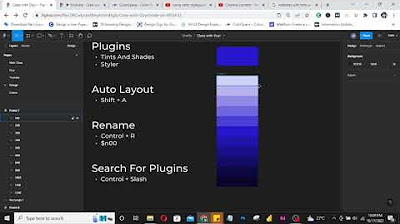🎨 Bingung Memilih Warna? Tonton Video Ini
Summary
TLDRThis video script guides viewers through the process of selecting colors for design and illustration. It explains the basics of the color wheel, including primary, secondary, and tertiary colors, and introduces color harmony concepts like complementary, triadic, analog, and monochromatic schemes. The video emphasizes the importance of creating a balanced palette to avoid confusion during design, while also touching on color psychology and the use of dominant colors. Tips on choosing the right color composition are shared, along with methods to use color harmony tools and online resources for creating effective palettes.
Takeaways
- 😀 Understanding the color wheel is essential for determining harmonious colors in your design.
- 😀 The color wheel consists of three main groups: primary, secondary, and tertiary colors.
- 😀 Primary colors (red, yellow, and blue) combine to form secondary colors (green, orange, purple).
- 😀 Tertiary colors are mixtures between primary and secondary colors, like magenta from red and purple.
- 😀 Creating a color palette helps plan and organize colors in your design, avoiding confusion during the process.
- 😀 The psychology of colors can guide your design choices, such as using blue for calm or red for anger.
- 😀 A dominant color in your design sets the tone, and secondary colors should complement it.
- 😀 Color harmonies like complementary, triadic, tetradic, analogous, and monochromatic ensure balanced designs.
- 😀 When working with monochromatic harmony, different tones, shades, and tints of a color can be used.
- 😀 Use the 60-30-10 rule for a balanced composition: 60% dominant color, 30% secondary color, and 10% accent color.
Q & A
What is the main topic discussed in the video?
-The video discusses how to choose colors for illustrations and designs, focusing on color harmony and color theory to help create visually appealing artwork.
What is the role of color theory in the design process?
-Color theory helps determine which colors work well together by understanding the relationships between primary, secondary, and tertiary colors, which ensures a balanced and harmonious design.
What are primary colors, and can you provide examples?
-Primary colors are the fundamental colors that cannot be created by mixing other colors. The primary colors are red, yellow, and blue.
What are complementary colors, and how are they used?
-Complementary colors are those that are opposite each other on the color wheel. They create a high contrast and can be used to make certain elements in a design stand out, such as using red and green together.
What is a triadic color scheme?
-A triadic color scheme uses three colors that are evenly spaced around the color wheel, creating a vibrant and balanced combination. An example is red, yellow, and blue.
How does the tetradic color scheme differ from the triadic scheme?
-The tetradic color scheme uses four colors arranged in two complementary pairs, which provides a rich and dynamic palette. It contrasts with triadic, which only uses three colors.
What is the difference between analog and complementary color schemes?
-Analog colors are next to each other on the color wheel and work well together to create a serene, harmonious look. In contrast, complementary colors are opposite each other and create more dynamic contrast.
How can color psychology be applied in design?
-Color psychology involves using colors to evoke specific emotions or responses. For example, blue can convey calmness, while red is often associated with passion or anger.
What are tones, shades, and tints in color mixing?
-A tone is created by adding gray to a color, a shade is made by adding black, and a tint is produced by adding white. These variations help create depth and dimension in color choices.
What is the 60-30-10 color rule and how does it help in design?
-The 60-30-10 color rule suggests using 60% of one dominant color, 30% of a secondary color, and 10% of an accent color. This balance creates a well-proportioned and harmonious design.
Outlines

This section is available to paid users only. Please upgrade to access this part.
Upgrade NowMindmap

This section is available to paid users only. Please upgrade to access this part.
Upgrade NowKeywords

This section is available to paid users only. Please upgrade to access this part.
Upgrade NowHighlights

This section is available to paid users only. Please upgrade to access this part.
Upgrade NowTranscripts

This section is available to paid users only. Please upgrade to access this part.
Upgrade Now5.0 / 5 (0 votes)





